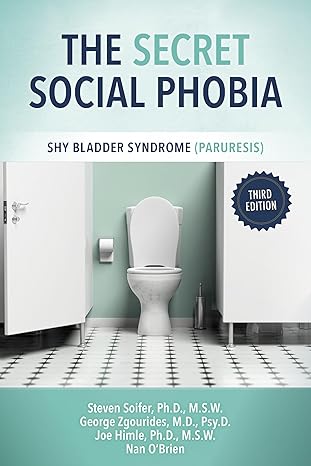Urinary Catheters
Catheters are small rubber or plastic tubes that can be inserted through the urethra into the bladder. Catheters are an almost sure-fire way to empty the bladder. Both men and women can use catheters.
You may have had some experience, perhaps an unpleasant experience with catheters if you were ever hospitalized for surgery. Usually, the catheters used in hospitals are “Foley” catheters, which have an inflatable balloon on them to keep them in place inside your bladder. Although paruresis sufferers may find some uses for Foley catheters, the kind of catheter we are talking about here is NOT designed to be held in place. Rather, the catheters our participants use do not have the inflatable balloon, and are intended to be inserted, held in place for perhaps 10 seconds to 60 seconds, and then immediately removed. This process is known as intermittent catheterization. It is used when necessary, and the catheter is not left in place as is commonly done in hospital practice.
People with paruresis who use catheters perform what is known as clean-intermittent-catheterization (CIC). That means the catheters are inserted as needed, on an intermittent basis. It also means the catheters don’t need to be sterile. They just need to be thoroughly clean. However in recent years sterile catheter prices have dropped tremendously and there are now many good single use sterile catheters on the market. Also, nowadays Medicare and many private health insurance companies will pay for catheters. Therefore, it is now usually no longer necessary to clean and reuse them, instead use sterile catheters whenever possible.
The use of catheters to empty the bladder is easy, quick, discreet, and should not be painful.
There is some risk of infection, especially in women, but your physician can appropriately deal with this risk.
Catheters are easily carried in a woman’s purse, a man’s pants pocket, or carry-on luggage. They are easily stored in desk drawers and automobile glove compartments or consoles. Many users place them within a zip-lock bag, along with a packet of a water soluble sterile lubricating jelly and a disposable hand wipe.
Here are examples of the type of lubricant which is appropriate: E-Z Lubricating Jelly (water soluble sterile 0.1 oz = 3 g); Aplicare #82-280; Fougera Surgilube, 3 g packets. There are undoubtedly other similar products on the market. For many years KY Jelly was recommended, however we have heard that it is no longer sold as a sterile product. If you can find sterile KY Jelly in small packets, it should work too. We suggest avoiding larger multi-use tubes of lubricant. You might wish to follow your doctor’s advice on brand, or choose what you like. However, NEVER use Vaseline or any lubricant other than a sterile water soluble lubricating jelly appropriate for catheter insertion. Use caution when purchasing “personal lubricants” as these may not be suitable for catheter insertion.
There are catheters that do not need lubrication. One brand name is LoFric. These seem to be popular in Europe and the UK. They are available in the USA too. The decision about which type to use is always a matter of personal choice, arrived at in consultation with your physician.
Catheters are available in a number of different styles, sizes, and materials. Anyone who decides to try them will need to do some experimenting to find out which kind works best. It is a very individual choice.
Catheters are manufactured from latex rubber, silicone, PVP plastic, other types of plastic, even Teflon. You may find one material to be more comfortable than another. Persons with latex allergy need to avoid rubber catheters. Most IPA members seem to like Cure brand catheters and Bard (Bardia) red rubber catheters.
The inserted end of catheters is manufactured with different shapes. We recommend against the use of catheters with tapered tips unless your doctor wants you to use that type of catheter. You should decide what is best for you through consultation with your doctor and experimentation with different brands, sizes, styles, and materials.
Some catheters have a slight bend near the tip. These are called Coude catheters. Many men prefer the Coude shape (some women find them easier to insert as well), but one must be careful to keep the proper orientation of the catheter tip while inserting it. Coude catheters are manufactured with marking on them to help you keep the proper orientation of the catheter throughout the insertion process; usually it is a “dimple” on the funnel end, but it might be guide marks, as are found on some Mentor Brand catheters.
While it is possible to obtain catheters and learn to use catheters without medical supervision, there are serious risks involved without proper training and instruction. IPA strongly advises everyone to get a physician’s approval and instruction in catheter use before trying them. Once you’ve been trained, you can safely and confidently use a catheter whenever it is needed to drain your bladder in an emergency situation, or for providing a urine sample during a drug test.
Catheters can be purchased at medical supply stores, some drug stores, and through on-line mail-order medical supply companies. Usually, no prescription is needed unless you want your insurance company to pay—but practices vary from store to store, and from state to state. The prescription requirements seem to vary throughout the country. We recommend that people who use catheters obtain a note of authorization from their physician, and keep this note with them at all times; especially for air travel. However, TSA has no issues with the catheters themselves, and the lubricant can be taken through the check point in your 1 Q baggie. Please remember to bring extras and pack extras for your time away and your return trip in your luggage.
There are also external catheters available that don’t need to be inserted into the urethra. Some of our participants like them, but they require that you can control the urinary muscles in order to drain your bladder. Therefore many of us cannot use them. External catheters have a rubber sleeve that fits over the penis, a collection bag, and a system of valves and drain tubing to connect up to the bag. There is a product for women too. External catheters can be worn discreetly and a number of people have reported they can be useful. These are often available without prescription in medical supply stores, and there is a product available on-line called the Stadium Pal (Stadium Gal for women.) For those who can use external catheters with leg bags to collect urine, they may be very helpful. If considering this option, remember that security personnel might give you a pat-down search for hidden objects and you may need to explain about the external catheter and leg bag. Probably these should not be used for air travel these days; check the TSA web sites for guidance.
Frequently Asked Questions
Try a medical supply store in your community, or use a search engine to find a medical supply store on line. Also, your physician can help you locate a supply store.
YES. See our page on Catheter tips for women for more information.
It varies. Reusable rubber catheters run between about $7.00 and $12.00. Remember, they can be cleaned and reused many times. Disposable catheters may cost as little as .50 cents. One on-line retailer is selling Cure brand Coude Catheters for .79 cents each. They are usually sold in cartons of 30, but some supply stores will sell them individually. Some people wash and reuse disposable catheters. While it is best to not reuse catheters, and usually not necessary with today’s modest prices, washing and reusing catheters was a common practice until just a few years ago.
This depends on the diameter of the catheter and how much urine needs to be expelled. A few seconds to a minute is an average time. It takes a minute or less to lubricate a catheter and insert it.
Urine will start to flow. Once the flow starts you will not be able to stop it until your bladder is completely empty. When the flow stops it is time to remove the catheter. While extremely unlikely to happen very small diameter catheter can be over inserted and become knotted. A urinary catheter should only be inserted to the point that urine is obtained – then stop. We suggest sticking with 12 – 14 Fr catheters unless directed otherwise by your physician. The 14 Fr for rubber and 12 Fr for plastic are often good “default” choices. Again, individual preferences and medical advice need to be considered. “Fr” indicates “French,” and is merely a designation for diameter of the catheter. The larger the number – the larger the catheter.
There are two types of catheters. Disposable catheters are designed for single use. Disposable catheters are packed in sterile packages and are sterile when first taken from their package. Try to avoid touching the lower sterile end and keep it from touching any surface such as a sink.
Reusable catheters do not need to be sterile. It is sufficient to clean them with water and a little soap, then rinse them well with water and again if possible with ordinary rubbing alcohol. Let them dry. Isopropyl alcohol (rubbing alcohol) is available inexpensively at most retail pharmacies. After cleaning, rinse once with 70% alcohol and then with 90-91% alcohol to help dry the catheter. If you need to quickly reuse them, rinsing with water is sufficient. Tap water will do. We recommend against using the water available in airplane lavatories or other places where the water is stored in containers. CAUTION—rubbing alcohol is sometimes impossible to find in other countries, so plan ahead when traveling abroad, and DO NOT ATTEMPT TO BRING ALCOHOL IN YOUR LUGGAGE. IT IS A FLAMMABLE LIQUID. IMPORTANT: Advances in the manufacture of catheters should make reusing catheters a thing of the past. The Cure Brand catheters are excellent and inexpensive. Many participants who have tried them have shared very positive comments about them with us. But, every person is different. There are distinct personal preferences and physician preferences to be considered in making your choices.
There may be a slight residual urge that will quickly pass. There might be a slight burning sensation. The first time you urinate after having used a catheter there might be a brief mild burning sensation. With time and practice you will feel nothing unusual and catheter use will become a non-event.
Talk to your primary doctor or call around to various urologists in your community. It seems that about 50% of the urologists will readily agree to teach you how to use catheters and the other 50% will adamantly refuse to help you. So call around before making an appointment. Ask to speak with the nurse. Explain that you will want to be taught how to do intermittent self-catheterization. Ask if the doctor is likely to agree to teach that to you. Do not agree to any expensive tests until you obtain a commitment that you will be taught how to use catheters.
While it is not possible to predict what any individual doctor might do, we have two recommendations. Download and print “Paruresis: Symptoms, Diagnosis & Treatment” from the American Urological Association Foundation. Bring it with you, and ask the doctor to read it before he examines you or talks with you about the reason for your visit. The article is short, and will only take the doctor a minute or two to read. We’ve highlighted the important section. Also, feel free to share this flyer “5 1/2 Things for Urologists” which has been previously sent to Urologists across the country for staff training.
It all depends on you. Some people are more squeamish than others or more sensitive internally. We recommend that you practice at home a few times before going out into situations where you may need the catheter.
Most people use them infrequently, as an emergency aid when they cannot find a place where they can empty their bladder. Usually, catheters might be used once or twice during a trip, visit, or event. It is OK to use them more regularly. But, most paruretics don’t find that necessary.
Yes, there is an infection risk. But, there are things you can do to reduce your risk. Men can use disposable iodine or other disinfectant wipes to cleanse the glans penis before inserting the catheter, and perhaps wear disposable sterile gloves. Drink plenty of fluids at the first opportunity after using a catheter, when you know you will be able to safely use a toilet. Empty your bladder frequently. Perhaps drink especially cranberry juice. Perhaps take cranberry pills that are sold over the counter.
There are both over the counter and prescription medicines that can help prevent infections or treat infections. Usually it is not necessary to take these though it is a good idea to have them on hand. Your physician can help you decide what to use.
This is a rare problem that either goes away quickly or may be a symptom of infection if it persists. There are some over the counter medicines containing phenazopyridine that tinge your urine a red color and provide a mild anesthetic effect. Most people will not need this. Phenazopyridine is also helpful for relieving the symptoms of an infection. It does not treat the infection. There is also a prescription form of this medicine and there are some other medicines that may be helpful. This is something you should discuss with your doctor.
Some believe that any action that allows a person with paruresis to avoid urinating in a public restroom will harm their efforts at recovering. But, IPA has not established that catheter use is indeed harmful. There is no clear answer at this time. Our members have reported that having a catheter with them provides an extra measure of security and a reduction in anxiety, because they know there will always be a way to drain the bladder if they encounter a situation that is beyond their ability to cope.
As of this writing, it is IPA’s opinion that catheter use can be very helpful for managing paruresis, but it is not substitute for working on recovery. In other words, catheters should be used only on an occasional basis, and only after other methods have failed to work (such as trying to reduce anxiety, trying different restrooms, etc.) Catheter use is also valuable if a person needs to produce a urine sample for a drug test and cannot risk being accused of drug use because they cannot provide the sample. The decision to use catheters, and under what circumstances with what frequency is a very personal and individual decision that can only be made by each individual with input from their own doctor.
Catheter use is not a substitute for a recovery program that includes support groups, graduated exposure therapy, and cognitive behavioral therapy. As a person works on a recovery program the need for a catheter should decrease over time.
QUICK LINKS
INTERNATIONAL PARURESIS ASSOCIATION
P.O. Box 21237
Catonsville, MD 21228
You Are Not Alone.
There Is Help For You!
Shy Bladder, Bashful Bladder, Pee Shy
IPA OFFICE HOURS
Monday - Friday
10:00am - 6:00pm (ET)
844-I-CANT-PEE (422-6873)
US/Canada
443-315-5250 Office
Email: getinfo@paruresis.org
This website is NOT a substitute for medical or legal advice and does not constitute the practice of law, medicine, psychiatry, clinical psychology, clinical social work, or any other mental health profession. If you are having trouble urinating, you should always contact a physician since difficulty with voiding can be a symptom of a serious medical condition. We are a group of professional people and people who have suffered with paruresis. We have assembled a board and a board of advisors to help people cope with urinary dysfunction that has a psychological or social origin. On this website, we are NOT practicing medicine, psychiatry, clinical psychology, clinical social work or any other mental health profession. You should have your doctor evaluate your condition before diagnosing yourself, and seek the appropriate necessary mental health counseling if warranted. IPA, Inc. disclaims any and all legal liability whatsoever. Use of the term “member” or “membership” refers to donors above $100 each July 1 to June 30 period and does not convey any legal or ownership rights in IPA.




